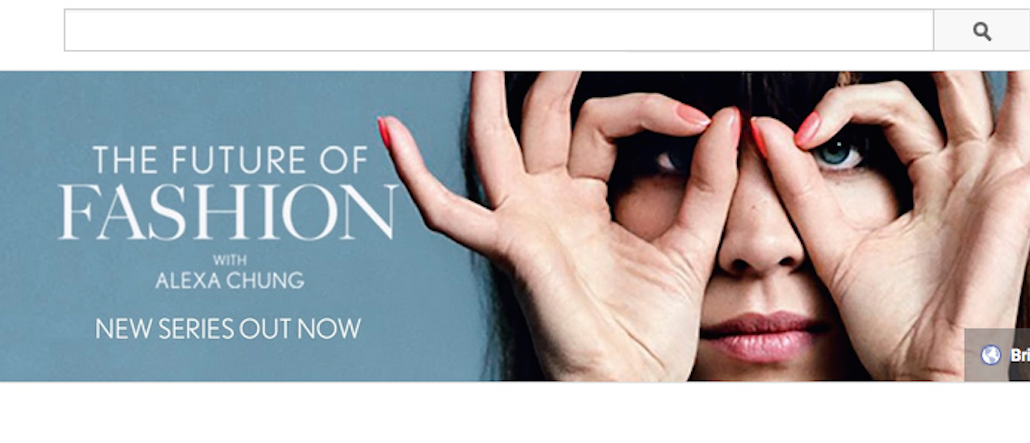Save 50% on a 3-month Digiday+ membership. Ends Dec 12.

Even in the midst of the current the ad-blockalypse, there is a glimmer of hope for publishers, according to research from Vogue UK, exclusive to Digiday. A new study, carried out by YouGov, found that 82 percent of the Condé Nast’s titles’ target readership pays attention to ads on magazine sites.
The 2015 British Vogue Business Report looks at evolving reader relationship with magazines in print and online, polling 2,787 upper-middle-class women aged 20-54.
Overall this target market’s engagement with magazine brands has gone up, as has engagement via social channels and on mobile. No real surprises there. However one of its more unlikely findings was that “attention to advertising across all platforms has never been higher, with significant increases for websites and digital editions.”
Vogue ads ‘as important as the content’
Overall, three-quarters of under-35s trust advertising and other paid-for communications; this has risen 6 percent since 2013. A further 82 percent of respondents pay attention to advertising on websites (this jumps to 94 percent of magazine readers) and has increased by 15 percent in two years.
With premium ads, seen in the likes of Vogue, readers are still interested, even going as far as to value them as much as they would the content. According to Vogue’s associate publisher Sallie Berkerey, the ads were described as “genuine,” “trusted” and “appealing.”
 The growing fear that more people are blocking ads is not as applicable to the upper-middle-class female demographic (who incidentally were “vanguardists” or second-wave purchasers of the latest technology). A Condé-funded study that shows Condé readers enjoy ads may cause some eyes to roll, but this line of thought doesn’t stop here. JPMorgan this week released a survey polling 520 U.S. Internet users. Its conclusion: Ad blocking is not as much of a problem as it is portrayed to be.
The growing fear that more people are blocking ads is not as applicable to the upper-middle-class female demographic (who incidentally were “vanguardists” or second-wave purchasers of the latest technology). A Condé-funded study that shows Condé readers enjoy ads may cause some eyes to roll, but this line of thought doesn’t stop here. JPMorgan this week released a survey polling 520 U.S. Internet users. Its conclusion: Ad blocking is not as much of a problem as it is portrayed to be.
JPMorgan analysts argued that ad blocking was a desktop problem, finding that people were half as likely to block ads on mobile. Additionally, the report notes that the fear-mongering around Apple’s OS allowing ad blocking for the first time “appear to be overblown.”
This was reiterated by Berkerey, who told Digiday that ad blocking is not the problem portrayed “certainly in the context of readers and users of glossy magazine brands in print and online, where advertising is part of the experience.” She added that this report will go some way in giving back advertisers the confidence in the choices they make with online magazines. As JPMorgan puts it, “Blockers remove low-quality ad clutter.”
This call for higher-quality ads is echoed by James Schad, innovation director at media agency Vizeum, who tells Digiday that future publisher success lies “in their ability to make more revenue from a fewer number of more effective ads.” Native, video and branded content is a short- to medium-term solution.
YouTube beats Facebook
Condé Nast’s report shows Vogue’s target is most interested in consuming content, and branded content, on YouTube, which has overtaken Facebook as the go-to site, with 88 percent getting their fix there.
Half of millennials surveyed want to see more video content from high-end brands and two-thirds want to see more exclusives.
Vogue’s target audience seems open and receptive to its ads. Even so, it seems no one really likes autoplay, especially not on mobile. And please don’t make them pinch and zoom.
Right time, right place
Data-led targeting is the vehicle for keeping readers interested in ads. Vogue’s Business Report notes the importance of highly relevant ads for upper-middle class readers who are buying high-end products.
Losing this, rather than diminishing revenues, is what would be at stake for Vogue if attention in ads were to decline and readers were to turn to ad blockers. These prevent tracking, so publishers learn less about their readers and are unable to serve them the relevant content. It would eventually lead to loss of revenue, but the industry fixation on revenue loss is, in JPMorgan’s word’s, “overdone.”
Katie MacLennan, Digital Business Director at Manning Gottlieb OMD follows on from this by saying that “with the continued emergence of greater user choice, personalization and dynamic ads, advertisers should present a compelling story which invites users to engage, rather than imposing content upon them.”
Clearer attribution, credible partnerships and more quality measures such as viewability, and interactivity, she says, is the way forward. Only then can all ad quality increase to the standard Vogue readers have come to expect.
More in Media

Digiday+ Research: Publishers’ growing focus on video doesn’t translate to social platforms
Major publishers have made recent investments in vertical video, but that shift is not carrying over to social media platforms.

Technology x humanity: A conversation with Dayforce’s Amy Capellanti-Wolf
Capellanti-Wolf shared insight on everything from navigating AI adoption and combating burnout to rethinking talent strategies.

How The Arena Group is rewriting its commercial playbook for the zero-click era
The company is testing AI-powered content recommendation models to keep readers moving through its network of sites and, in doing so, bump up revenue per session – its core performance metric.





